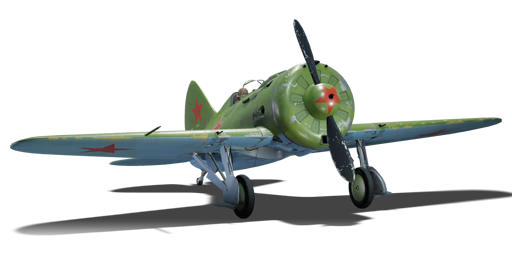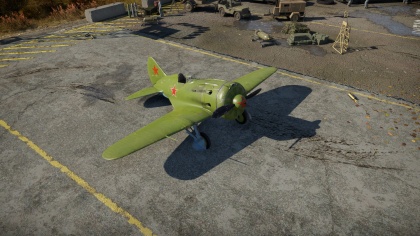I-16 type 24
Contents
| This page is about the Soviet fighter I-16 type 24. For other versions, see I-16 (Family). |
Description
The I-16 type 24 Ishak is a rank I Soviet fighter
with a battle rating of 2.3 (AB) and 2.7 (RB/SB). It was introduced in Update 1.39.
General info
Flight performance
The I 16 is a famous turn fighter. It turns in a blink of an eye but that's about it. The I-16 has a small engine which can't reach great speeds. It's slow, it can't climb and has poor energy retention. The 95 octane fuel helps a lot for the performance.
| Characteristics | Max Speed (km/h at 4,400 m) |
Max altitude (metres) |
Turn time (seconds) |
Rate of climb (metres/second) |
Take-off run (metres) | |||
|---|---|---|---|---|---|---|---|---|
| AB | RB | AB | RB | AB | RB | |||
| Stock | 441 | 425 | 9300 | 17.4 | 17.9 | 15.0 | 15.0 | 210 |
| Upgraded | ___ | ___ | __._ | __._ | __._ | __._ | ||
Details
| Features | ||||
|---|---|---|---|---|
| Combat flaps | Take-off flaps | Landing flaps | Air brakes | Arrestor gear |
| ✓ | ✓ | ✓ | X | X |
| Limits | ||||||
|---|---|---|---|---|---|---|
| Wings (km/h) | Gear (km/h) | Flaps (km/h) | Max Static G | |||
| Combat | Take-off | Landing | + | - | ||
| 0 | 260 | 420 | 320 | 260 | ~14 | ~7 |
| Optimal velocities (km/h) | |||
|---|---|---|---|
| Ailerons | Rudder | Elevators | Radiator |
| < 300 | < 240 | < 280 | > 190 |
Survivability and armour
The aircraft's engine is small but incredibly vulnerable. It's useless after only a few hits. The construction is weak and can't withstand a lot of punishment. The pilot is exposed and the fuel tanks catch fire and explode fast. All this compensated by its manoeuvrability, which can be enough to avoid being hit. Avoid flying above AAA, because the plane and the pilot are vulnerable to them.
Armaments
Offensive armament
The I-16 type 24 is armed with:
- 2 x 7.62 mm ShKAS machine guns, nose-mounted (650 rpg = 1,300 total)
- 2 x 7.62 mm ShKAS machine guns, wing-mounted (900 rpg = 1,800 total)
Suspended armament
The I-16 type 24 can be outfitted with the following ordnance:
- Without load
- 2 x 100 kg FAB-100 bombs (200 kg total)
- 2 x 50 kg FAB-50 bombs (100 kg total)
- 6 x RS-82 rockets
- 6 x RBS-82 rockets
Usage in battles
This is a classic turn fighter. It can outmanoeuvre anything in the sky at its BR, so the main tactic is tricking the enemy into a turn fight. You have to come close to the enemy because you only have MG-s, but when you get close the ShKAS machine gun spews 1,800 rpm so even though it's a small calibre for aircraft it does the job. You can also take rockets to destroy stray bombers from a distance, or destroy ground targets with rockets and bombs. If you must destroy AAA, get low to the ground, pull up at the last minute and fire away. The pilot is vulnerable to AAA fire.
Simulator:
The I-16 can be used in turnfighting, bomber intercepting and ground pounding. However in this mode, its characteristics appear to be quite conflicting. It is excellent in turning tightly and continuously, yet when maneuvering it easily gets into uncontrollable spins which isn't beginner friendly. Also the rather big nose blocks the visibility a lot, offering very poor over-the-nose visibility which is a disadvantage in a turn fight, because when leading a shot the enemy will always get obstructed by the engine, making the player guess the shot. More ever, there is no trim control available in a sim battle and the I-16 always pitch up and down. Although not a lot, it is still annoying when trying to get a precise aim.
It is recommended to set the convergence within 300m, with vertical convergence on, because the majority of turnfights happen at that range or closer.
Before engaging a fight, it is better to have an altitude advantage first. When approaching the fight try to figure out which is your teammate and which is the enemy, to avoid going for a second pass, as the energy retention of the I-16 is rather slow. Also pick your target carefully. For easier aiming, you want to go for those unmaneuverble twin engine aircraft like Ju 88 or Ki-45, or bombers if there are any. Given the bad forward visibility of the I-16, these are the best options as they are quite slow and sluggish, and are a bigger target to hit. However getting hits on them tend to do little work, as your MGs lack damage. When dealing with fighters, it is way harder to aim. The elevator control of the I-16 is extremely sensitive, giving it good maneuverbility, but at the same time, bad handling. The I-16 will respond in a very fast turn upon moving your stick / mouse by a little bit, which makes tracking nimble planes quite hard. But once you get used to it, try to lure every enemy into a turnfight, as that is where the I-16 shines. Quite a bit of bullets are required to effectively damage the enemy so you must be patient. If you find an enemy at your 6, utilise your great roll rate to do defensive maneuvers like scissors to make them overshoot. Or you can simply do tight turns, most monoplanes won't be able to cut inside your turn and they might disengage. Important note: DO NOT put too much rolling and pitching input at once, as aforementioned the I-16 tend to enter spins easily.
Manual Engine Control
| MEC elements | ||||||
|---|---|---|---|---|---|---|
| Mixer | Pitch | Radiator | Supercharger | Turbocharger | ||
| Oil | Water | Type | ||||
| Controllable | Controllable Not auto controlled |
Not controllable Not auto controlled |
Controllable Not auto controlled |
Combined | Controllable 2 gears |
Not controllable |
Modules
| Tier | Flight performance | Survivability | Weaponry | ||
|---|---|---|---|---|---|
| I | Fuselage repair | Radiator | Offensive 7 mm | DZ-40 | |
| II | Compressor | Airframe | RO-82 | ||
| III | Wings repair | Engine | New 7 mm MGs | ||
| IV | 95 octane fuel usage | Engine injection | Cover | ||
Pros and cons
Pros:
- Excellent turning ability- with combat flaps deployed it can out-turn any Bf 109, Fw 190 A and even turn-fighters like the Spitfire
- Extreme roll rate allows it to do offensive/defensive scissors easily, which is an advantage over Bf 109 and Spitfire as their roll rates aren't as good.
- 4 x ShKAS machine guns with good fire rate, adequate velocity and accuracy, and plenty of ammo (1,300 rounds total) for longer battles
- Suspended armament provides rockets and bombs, which, to some extent, allows some ground attack ability.
- Is a very short and small plane, offering the enemy a harder target to hit.
Cons:
- Extremely poor level speed, climb rate, dive acceleration and energy retention- will get outran, out-climbed and out-dived easily by Bf 109 E/F, Fw 190 A or A6M2
- Engine tends to overheat when diving at more than 500 km/h
- Control surfaces are unresponsive over 450 km/h
- Flaps are very weak and will break over 250 km/h, severely limiting its sharp-turning potential at higher speeds
- No manual trim controls in simulator which makes it hard to handle
- Although manoeuvrable, it can still get out-turned by some Japanese turn-fighters
History
Describe the history of the creation and combat usage of the aircraft in more detail than in the introduction. If the historical reference turns out to be too long, take it to a separate article, taking a link to the article about the vehicle and adding a block "/History" (example: https://wiki.warthunder.com/(Vehicle-name)/History) and add a link to it here using the main template. Be sure to reference text and sources by using <ref></ref>, as well as adding them at the end of the article with <references />. This section may also include the vehicle's dev blog entry (if applicable) and the in-game encyclopedia description (under === In-game description ===, also if applicable).
Media
Excellent additions to the article would be video guides, screenshots from the game, and photos.
See also
Links to the articles on the War Thunder Wiki that you think will be useful for the reader, for example:
- reference to the series of the aircraft;
- links to approximate analogues of other nations and research trees.
External links
Paste links to sources and external resources, such as:
- topic on the official game forum;
- encyclopedia page on the aircraft;
- other literature.
| Polikarpov Design Bureau (Опытное конструкторское бюро Поликарпова) | |
|---|---|
| I-15 | I-15 WR · I-15 M-22 · I-15 M-25 · I-15bis · Krasnolutsky's I-15bis |
| I-153 | I-153 M-62 · Zhukovsky's I-153-M62 · I-153P |
| I-16 | I-16 type 5 · I-16 type 10 · I-16 type 18 · I-16 type 24 · I-16 type 27 · I-16 type 28 |
| I-180 | I-180S · I-185 (M-71) · I-185 (M-82) |
| ITP | ITP (M-1) |
| Twin-engine fighters | TIS MA |
| Bombers | Po-2 · Po-2M |
| Export | ␗I-15bis · ␗I-153 M-62 · ␗I-16 type 5 · ␗I-16 type 10 · ␗I-16 type 17 · ␗I-16 Chung 28 |
| USSR fighters | |
|---|---|
| I-15 | I-15 WR · I-15 M-22 · I-15 M-25 · I-15bis · Krasnolutsky's I-15bis |
| I-153 M-62 · Zhukovsky's I-153-M62 · I-153P | |
| I-16 | I-16 type 5 · I-16 type 10 · I-16 type 18 · I-16 type 24 · I-16 type 27 · I-16 type 28 · I-180S |
| I-29 | I-29 |
| I-185 | I-185 (M-71) · I-185 (M-82) |
| I-225 | I-225 |
| ITP | ITP (M-1) |
| MiG-3 | MiG-3-15 · MiG-3-15 (BK) · MiG-3-34 |
| LaGG | I-301 · LaGG-3-4 · LaGG-3-8 · LaGG-3-11 · LaGG-3-23 · LaGG-3-34 · LaGG-3-35 · LaGG-3-66 |
| La | La-5 · La-5F · La-5FN · La-7 · Dolgushin's La-7 · La-7B-20 · La-9 · La-11 |
| Yak-1/7 | Yak-1 · Yak-1B · Yak-7B |
| Yak-3 | Yak-3 · Eremin's Yak-3(e) · Yak-3P · Yak-3T · Yak-3U · Yak-3 (VK-107) |
| Yak-9 | Yak-9 · Yak-9B · Golovachev's Yak-9M · Yak-9T · Yak-9K · Yak-9U · Yak-9UT · Yak-9P |
| Other countries | ▂P-40E-1 · ▂P-47D-27 · ▂Hurricane Mk IIB · ▂Fw 190 D-9 · ▂Spitfire Mk IXc |
| P-39 | ▂P-39K-1 · ▂Pokryshkin's P-39N-0 · ▂P-39Q-15 |
| P-63 | ▂P-63A-5 · ▂P-63A-10 · ▂P-63C-5 |





